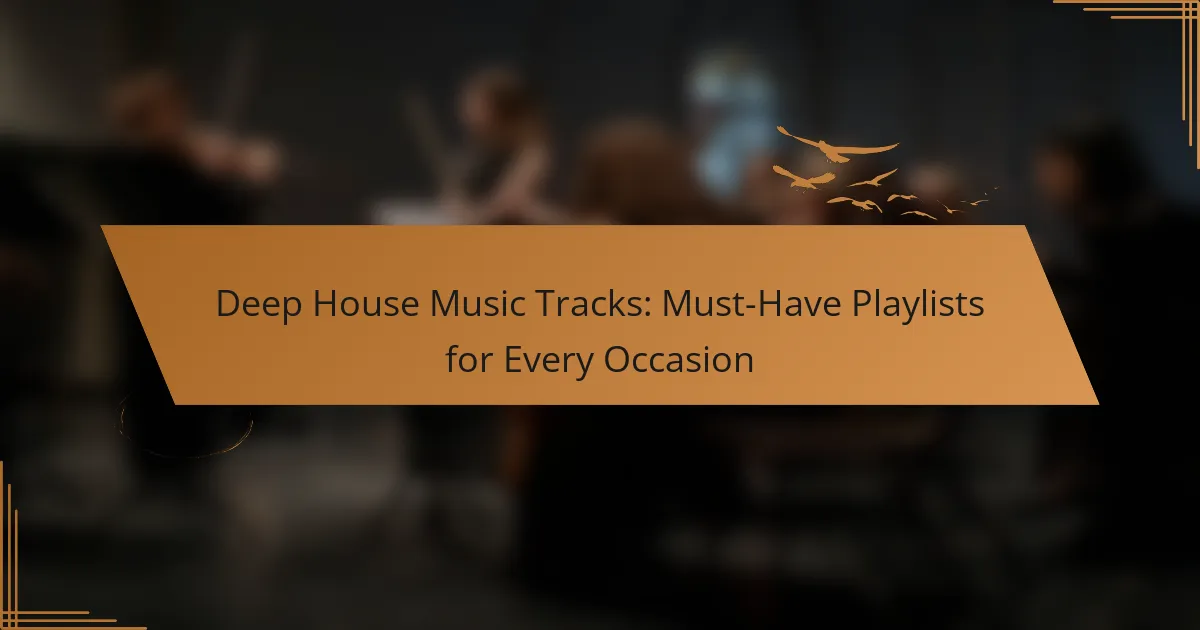Deep House Music is a subgenre of house music known for its complex melodies and deep basslines, typically featuring slower tempos between 120 to 125 BPM. This genre blends elements of jazz, soul, and funk, creating a smooth and atmospheric sound that has gained popularity in clubs and festivals worldwide since its emergence in the 1980s. Essential playlists for deep house music, such as “Deep House Relax,” “Chill Deep House,” and “Deep House Essentials,” curate key tracks that enhance the listening experience and introduce listeners to both iconic and emerging artists. These playlists serve as vital resources for discovering the depth and variety of deep house music, suitable for various occasions from relaxation to parties.

What is Deep House Music?
Deep House Music is a subgenre of house music characterized by its complex melodies and deep basslines. It typically features slower tempos, usually around 120 to 125 BPM. Deep house incorporates elements of jazz, soul, and funk, creating a smooth and atmospheric sound. The genre emerged in the 1980s, with artists like Larry Heard and Frankie Knuckles influencing its development. Deep house tracks often include vocal samples and intricate chord progressions. This style has gained popularity in clubs and festivals worldwide. It is known for creating a laid-back yet engaging listening experience.
How did Deep House Music originate?
Deep House Music originated in the 1980s as a subgenre of house music. It emerged in Chicago, influenced by the city’s vibrant club scene. Key figures like Larry Heard and Frankie Knuckles played significant roles in its development. Deep house is characterized by its soulful vocals and complex melodies. The genre incorporates elements of jazz, funk, and soul. Over time, it gained popularity in Europe, particularly in the UK. The sound evolved, incorporating more electronic elements and atmospheric textures. Today, deep house remains a staple in clubs and music festivals worldwide.
What are the historical influences on Deep House Music?
Deep House Music is influenced by various historical genres and cultural movements. Its roots trace back to Chicago house music in the 1980s. Pioneers like Frankie Knuckles and Larry Heard shaped its sound with soulful melodies. The genre incorporates elements of jazz, funk, and disco. Additionally, the use of synthesizers and drum machines became prominent in its production. The Detroit techno scene also contributed to its evolution. As a result, Deep House blends rhythmic grooves with atmospheric sounds. This fusion has made it a staple in clubs and lounges worldwide.
Who are the key pioneers of Deep House Music?
Key pioneers of Deep House Music include Larry Heard, Frankie Knuckles, and Kerri Chandler. Larry Heard, also known as Mr. Fingers, is credited with shaping the sound of deep house in the 1980s. His track “Can You Feel It” is often cited as a seminal deep house record. Frankie Knuckles, known as the “Godfather of House,” played a crucial role in popularizing the genre in Chicago. His remixes and productions helped define the deep house sound. Kerri Chandler is another influential figure, known for his rich, soulful productions that have become classics in the deep house scene. These artists laid the foundation for deep house music, influencing countless producers and DJs.
What are the defining characteristics of Deep House Music?
Deep House Music is characterized by its smooth, soulful sound and deep basslines. It typically features slower tempos, usually between 120 to 125 BPM. The genre incorporates elements of jazz, funk, and soul music. Vocals in Deep House are often soft and melodic, creating an atmospheric vibe. The use of synthesized chords and ambient sounds is common. Deep House tracks often have a laid-back, relaxed feel, making them suitable for various occasions. Notably, the genre emerged in the 1980s, influenced by Chicago house music. Its unique blend of styles distinguishes it from other electronic music genres.
How does the tempo and rhythm distinguish Deep House Music?
Deep House Music is characterized by a tempo typically ranging from 120 to 125 beats per minute. This moderate tempo creates a laid-back yet danceable feel. The rhythm often incorporates intricate hi-hat patterns and syncopated basslines. These elements contribute to a smooth groove that invites listeners to engage. Additionally, Deep House often features soulful vocals and lush harmonies. This combination enhances the emotional depth of the music. The use of ambient textures further distinguishes it from other electronic genres. Overall, the specific tempo and rhythmic structure define the unique identity of Deep House Music.
What instrumentation is commonly used in Deep House tracks?
Deep House tracks commonly utilize synthesizers, basslines, and drum machines. Synthesizers create lush chords and melodic elements. Basslines provide a deep, rhythmic foundation. Drum machines are used for crafting the characteristic four-on-the-floor beats. Additionally, electric pianos and pads enhance the harmonic richness. Vocal samples often add a human touch to the music. These elements combine to create the smooth, atmospheric sound typical of Deep House.

Why are Must-Have Playlists important for Deep House Music?
Must-have playlists are important for deep house music because they curate essential tracks for listeners. These playlists enhance the listening experience by providing a cohesive flow of music. They help both new and seasoned fans discover key tracks and artists within the genre. Must-have playlists can also set the mood for various occasions, such as parties or relaxation. They often include popular tracks that define the deep house sound. This selection aids in promoting the genre by attracting a wider audience. Additionally, playlists can introduce listeners to emerging artists, fostering growth in the deep house community. Overall, must-have playlists serve as a vital resource for enjoying and exploring deep house music.
What occasions benefit from Deep House Music playlists?
Deep House Music playlists benefit various occasions, including parties, relaxation sessions, and social gatherings. These playlists create a vibrant atmosphere at parties, encouraging dancing and social interaction. During relaxation sessions, deep house music promotes calmness and helps reduce stress. Social gatherings, like dinner parties or celebrations, benefit from its smooth and melodic tones, enhancing conversations. According to a study by the University of Kent, music can significantly improve mood and social bonding, making deep house an excellent choice for these events.
How can Deep House Music enhance social gatherings?
Deep House Music enhances social gatherings by creating an inviting atmosphere. The genre’s smooth beats and melodic elements promote relaxation and conversation. It encourages social interaction by providing a consistent backdrop without overpowering dialogue. Studies show that music can influence mood and behavior in social settings. For instance, a study published in the Journal of Consumer Research found that background music can enhance the enjoyment of social interactions. Deep House Music’s tempo and rhythm facilitate a sense of flow among guests. This genre often evokes positive emotions, contributing to a lively and engaging environment. Overall, Deep House Music serves as an effective tool for elevating the social experience.
In what ways does Deep House Music suit relaxation and study environments?
Deep House Music suits relaxation and study environments through its soothing rhythms and melodic elements. The genre typically features a slow tempo, often around 120 to 125 beats per minute. This tempo promotes a calming atmosphere conducive to focus and relaxation. Additionally, Deep House incorporates smooth basslines and gentle synths, which create an immersive soundscape.
Research indicates that music with a steady beat can enhance concentration and productivity. A study published in the Journal of Experimental Psychology found that background music can improve cognitive performance in tasks requiring sustained attention. Moreover, the repetitive nature of Deep House tracks minimizes distractions, allowing listeners to maintain their focus.
These attributes make Deep House Music an ideal choice for individuals seeking a tranquil environment for studying or unwinding.
How do you curate a Deep House Music playlist?
To curate a Deep House Music playlist, start by selecting tracks that embody the genre’s signature sound. Deep House is characterized by smooth, soulful melodies and a steady 4/4 beat. Include a mix of classic and contemporary tracks to showcase the genre’s evolution. Pay attention to the flow and energy of the playlist, ensuring a seamless transition between songs. Incorporate tracks with rich basslines and atmospheric elements to enhance the listening experience. Consider the intended setting, such as a party or relaxation, to guide your selections. Research popular Deep House artists and their notable tracks for inspiration. Platforms like Spotify and SoundCloud can provide insights into trending songs within the genre.
What factors should be considered when selecting tracks?
When selecting tracks, consider the mood and atmosphere you want to create. The energy level of the track should align with the event’s vibe. Analyze the tempo, as it influences the pace of the gathering. The key of the track is important for harmonic mixing. Evaluate the lyrical content, ensuring it fits the audience’s preferences. Transition compatibility between tracks enhances the overall flow. Lastly, consider the audience’s demographics and musical tastes for better engagement.
How can transitions between tracks impact the listening experience?
Transitions between tracks can significantly impact the listening experience. Smooth transitions create a seamless flow, enhancing listener engagement. Abrupt transitions can disrupt the mood and break the immersive quality of the music. Research shows that well-executed transitions can maintain energy levels and sustain interest over longer listening periods. For example, DJ sets often utilize key and tempo matching to create harmonious transitions. This technique keeps the audience connected to the music. In contrast, poorly executed transitions may lead to listener fatigue or disconnection. Overall, effective track transitions are essential in shaping the overall enjoyment of deep house music playlists.

What are some recommended Deep House Music playlists?
Some recommended Deep House Music playlists include “Deep House Relax,” “Chill Deep House,” and “Deep House Essentials.” “Deep House Relax” features soothing tracks perfect for unwinding. “Chill Deep House” offers a mix of mellow beats and smooth melodies. “Deep House Essentials” includes iconic tracks that define the genre. These playlists are curated to showcase the depth and variety of deep house music. They can be found on popular streaming platforms like Spotify and Apple Music. Each playlist is updated regularly to include new releases and timeless classics.
What are the top Deep House tracks for parties?
Top Deep House tracks for parties include “Can’t Get Enough” by Soulsearcher, “Deep End” by John Summit, and “Cola” by CamelPhat & Elderbrook. These tracks are known for their infectious beats and melodic hooks. “Can’t Get Enough” features a classic vocal sample that energizes crowds. “Deep End” combines a groovy bassline with uplifting synths, making it a dancefloor favorite. “Cola” gained massive popularity for its catchy lyrics and deep bass. These tracks consistently appear in party playlists due to their ability to create an upbeat atmosphere.
Which artists should be included for an energetic vibe?
Artists that should be included for an energetic vibe in deep house music are Fisher, Gorgon City, and Calvin Harris. Fisher is known for his infectious beats and high-energy tracks like “Losing It.” Gorgon City combines house and electronic elements, creating dancefloor hits such as “Imagination.” Calvin Harris has a proven track record with energetic anthems like “I’m Not Alone.” These artists consistently produce music that energizes listeners and keeps the atmosphere lively. Their tracks are often featured in festivals and club playlists, reinforcing their status in the genre.
How can remixes enhance the party atmosphere?
Remixes can enhance the party atmosphere by providing fresh interpretations of popular songs. This keeps the energy high and engages the crowd. Remixes often incorporate unique beats and rhythms that encourage dancing. They can also create a sense of nostalgia by blending familiar melodies with modern sounds. This combination appeals to diverse musical tastes, making the experience enjoyable for everyone. Studies show that remixes can increase listener retention and excitement, leading to longer dance sessions. Additionally, remixes often feature unexpected drops and transitions that surprise and delight partygoers. This unpredictability keeps the atmosphere lively and dynamic throughout the event.
What Deep House playlists are ideal for relaxation?
Chill Deep House playlists ideal for relaxation include “Deep House Relax,” “Chill House Vibes,” and “Deep Focus.” “Deep House Relax” features soothing beats that promote tranquility. “Chill House Vibes” blends melodic elements with soft rhythms for a calming atmosphere. “Deep Focus” is designed for concentration while maintaining a relaxed mood. These playlists often contain tracks with slower tempos and ambient sounds. They are perfect for unwinding after a long day or enhancing a peaceful environment. Listening to these playlists can reduce stress and improve overall well-being.
Which tracks are known for their soothing qualities?
Tracks known for their soothing qualities in deep house music include “Sunset Lover” by Petit Biscuit and “Weightless” by Marconi Union. “Sunset Lover” features gentle melodies and calming rhythms, creating a tranquil atmosphere. “Weightless” is scientifically proven to reduce anxiety and promote relaxation. These tracks are often used in meditation and relaxation playlists. Their soothing qualities are characterized by soft beats and harmonious soundscapes.
How do ambient elements play a role in these playlists?
Ambient elements enhance deep house music playlists by creating a soothing atmosphere. These elements often include soft synth pads, nature sounds, and reverb effects. They contribute to the overall mood, making tracks feel immersive. Ambient sounds can evoke emotions and set a calming tone. Research indicates that ambient music promotes relaxation and reduces stress. This is particularly effective in playlists designed for social gatherings or relaxation. Therefore, the inclusion of ambient elements is crucial for achieving the desired emotional impact in deep house music playlists.
What tips can help you create the perfect Deep House Music playlist?
To create the perfect Deep House Music playlist, focus on a cohesive theme. Select tracks that share a similar vibe or mood. Incorporate a mix of well-known and lesser-known artists. This balance keeps the playlist fresh and engaging. Pay attention to the flow between songs. Transitioning smoothly enhances the listening experience. Consider the length of the playlist. Aim for a duration that suits the occasion, typically 1 to 2 hours. Regularly update the playlist to include new releases. This keeps it relevant and exciting for listeners.
How can you balance energy levels throughout the playlist?
To balance energy levels throughout a playlist, strategically arrange tracks by tempo and intensity. Start with lower BPM tracks to create a relaxed atmosphere. Gradually increase the tempo to elevate energy as the playlist progresses. Include peaks of higher energy tracks followed by brief downtimes to maintain listener engagement. Transition smoothly between tracks to avoid jarring shifts. Analyze the energy flow using tools like a track’s BPM and emotional tone. This method keeps listeners engaged and enhances their overall experience.
What are the best practices for updating playlists regularly?
Regularly updating playlists enhances listener engagement and keeps content fresh. Schedule updates at consistent intervals, such as weekly or monthly, to establish routine. Analyze listener data to identify popular tracks and trends. Incorporate new releases to maintain relevance in the genre. Remove underperforming songs to optimize the listening experience. Curate based on seasonal themes or events to resonate with current moods. Collaborate with other curators to diversify selections and introduce fresh perspectives. Engaging with your audience for feedback can also help refine playlist choices.
Deep House Music is a subgenre of house music known for its complex melodies, deep basslines, and slower tempos ranging from 120 to 125 BPM. The article provides a comprehensive overview of the genre’s origins, historical influences, and key pioneers, such as Larry Heard and Frankie Knuckles. It discusses the defining characteristics of deep house music, including instrumentation and rhythm, and highlights the importance of curated must-have playlists for various occasions, including parties and relaxation. Additionally, the article offers practical tips for creating and updating deep house playlists to enhance the listening experience.
